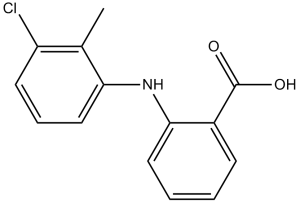Tolfenamic Acid (GEA 6414)
This product is for research use only, not for human use. We do not sell to patients.

For small sizes, please check our retail website as below: www.invivochem.com
| Size | Price | Stock |
|---|---|---|
| 50g | $480 | Check With Us |
| 100g | $800 | Check With Us |
| 200g | $1200 | Check With Us |
Cat #: V1059 CAS #: 13710-19-5 Purity ≥ 98%
Description: Tolfenamic Acid (formerly GEA 6414; GEA6414; GEA-6414; Clotam), a non-steroidal anti-inflammatory drugs (NSAIDs), is a potent and selective COX-2 inhibitor with potential anti-inflammatory activity.
Top Publications Citing Invivochem Products
Publications Citing InvivoChem Products
Product Promise

- Physicochemical and Storage Information
- Protocol
- Related Biological Data
- Stock Solution Preparation
- Quality Control Documentation
| Molecular Weight (MW) | 261.7 |
|---|---|
| Molecular Formula | C14H12ClNO2 |
| CAS No. | 13710-19-5 |
| Storage | -20℃ for 3 years in powder formrr |
| -80℃ for 2 years in solvent | |
| Solubility In Vitro | DMSO: 52 mg/mL (198.7 mM)rr |
| Water: <1 mg/mLrr | |
| Ethanol: <1 mg/mL | |
| SMILES Code | O=C(O)C1=CC=CC=C1NC2=CC=CC(Cl)=C2C |
| Synonyms | GEA-6414; Tolfenamic acid; GEA 6414; GEA6414; Clotam |
| Protocol | In Vitro | Tolfenamic acid (GEA 6414) (100 μM) inhibits >3% cell viability of BE33, OE5, and SKGT70. Tolfenamic acid (GEA 6414) is also a potent Sp protein inhibitor that reduces Sp1 and Sp4 and inhibits c-Met expression in esophageal cancer cells BE3 and SKGT5 |
|---|---|---|
| In Vivo | Tolfenamic acid (GEA 6414) (50 mg/kg three times/week orally) inhibits tumorigenesis and tumor incidence in N-nitrosomethylbenzylamine (NMBA)-induced oesophageal tumor models. Tolfenamic Acid (GEA 3) also resulted in reduced tumor diversity and tumor volume in NMBA-treated rats |
These protocols are for reference only. InvivoChem does not
independently validate these methods.
| Solvent volume to be added | Mass (the weight of a compound) | |||
|---|---|---|---|---|
| Mother liquor concentration | 1mg | 5mg | 10mg | 20mg |
| 1mM | 3.8212 mL | 19.1058 mL | 38.2117 mL | 76.4234 mL |
| 5mM | 0.7642 mL | 3.8212 mL | 7.6423 mL | 15.2847 mL |
| 10mM | 0.3821 mL | 1.9106 mL | 3.8212 mL | 7.6423 mL |
| 20mM | 0.1911 mL | 0.9553 mL | 1.9106 mL | 3.8212 mL |
The molarity calculator equation
Mass(g) = Concentration(mol/L) × Volume(L) × Molecular Weight(g/mol)
Mass
=
Concentration
×
Volume
×
Molecular Weight*
The dilution calculator equation
Concentration(start)
×
Volume(start)
=
Concentration(final)
×
Volume(final)
This equation is commonly abbreviated as: C1 V1 = C2 V2
Concentration(start)
C1
×
Volume(start)
V1
=
Concentration(final)
C2
×
Volume(final)
V2
Step One: Enter information below
Dosage mg/kg
Average weight of animals g
Dosing volume per animal µL
Number of animals
Step Two: Enter the in vivo formulation
%DMSO
+
%
+
%Tween 80
+
%ddH2O
Calculation Results:
Working concentration:
mg/ml;
Method for preparing DMSO master liquid:
mg
drug pre-dissolved in
µL
DMSO(Master liquid concentration
mg/mL)
,Please contact us first if the concentration exceeds the DMSO solubility of the batch of drug.
Method for preparing in vivo formulation:
Take
µL
DMSO master liquid, next add
µL
PEG300, mix and clarify, next add
µL
Tween 80,mix and clarify, next add
µL
ddH2O,mix and clarify.
Note:
- (1) Please be sure that the solution is clear before the addition of next solvent. Dissolution methods like vortex, ultrasound or warming and heat may be used to aid dissolving.
- (2) Be sure to add the solvent(s) in order.




































